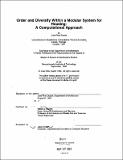Order and diversity within a modular system for housing : a computational approach
Author(s)
Duarte, José Pinto
DownloadFull printable version (62.29Mb)
Advisor
William J. Mitchell.
Terms of use
Metadata
Show full item recordAbstract
This thesis introduces elements of a methodology to achieve order and diversity in the systematic design of street facades within a modular system for housing. In its context both order and diversity refer to the spatial arrangement of architectural elements; order emphasizes repetition, whereas diversity emphasizes variation. The study addresses on one hand, the limitations of designers, design practice, and existing design theory principles in the achievement of diversity, and on the other, the opportunity provided by shape grammars, the use of evaluation rules, and the computer to develop a methodology that overcomes these limitations. The study starts by presenting a modular system developed for housing. Then it presents a set of experiments designed with the goal of discovering designers limitations to generate diversity and their perception of it. These experiments use a computer program developed to trace the design process of the experimental subjects. Results suggest that limitations in diversity are due to designers psychological tendency towards order. Three different perceived manifestations of order are identified: logic order, orderliness, and balance. Orderliness is shown to be closely related to diversity through repetition, and as such are referred to as orderliness-diversity. Based on the experimental results three algorithms are then presented: one for orderliness-diversity, and two for balance. A shape grammar and a computer program for generating facades are then developed based on the rules of the modular system and the rules developed by one of the experimental subjects within the system. In order to guarantee order and diversity, the three developed algorithms are then proposed to be used as evaluative rules of the designs generated by the shape grammar.
Description
Thesis (M.S.)--Massachusetts Institute of Technology, Dept. of Architecture, 1993. Includes bibliographical references (leaves 448-451).
Date issued
1993Department
Massachusetts Institute of Technology. Department of ArchitecturePublisher
Massachusetts Institute of Technology
Keywords
Architecture